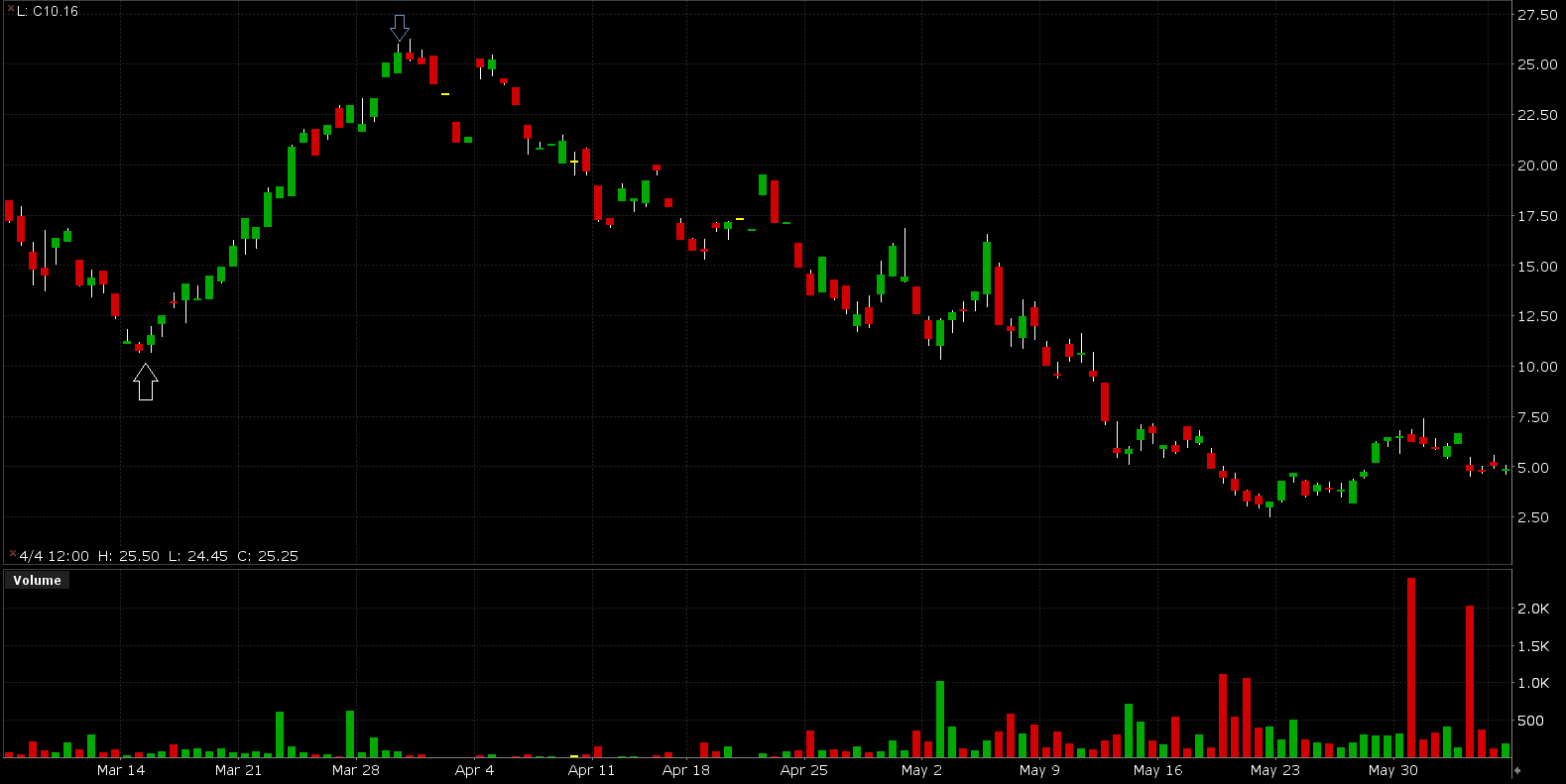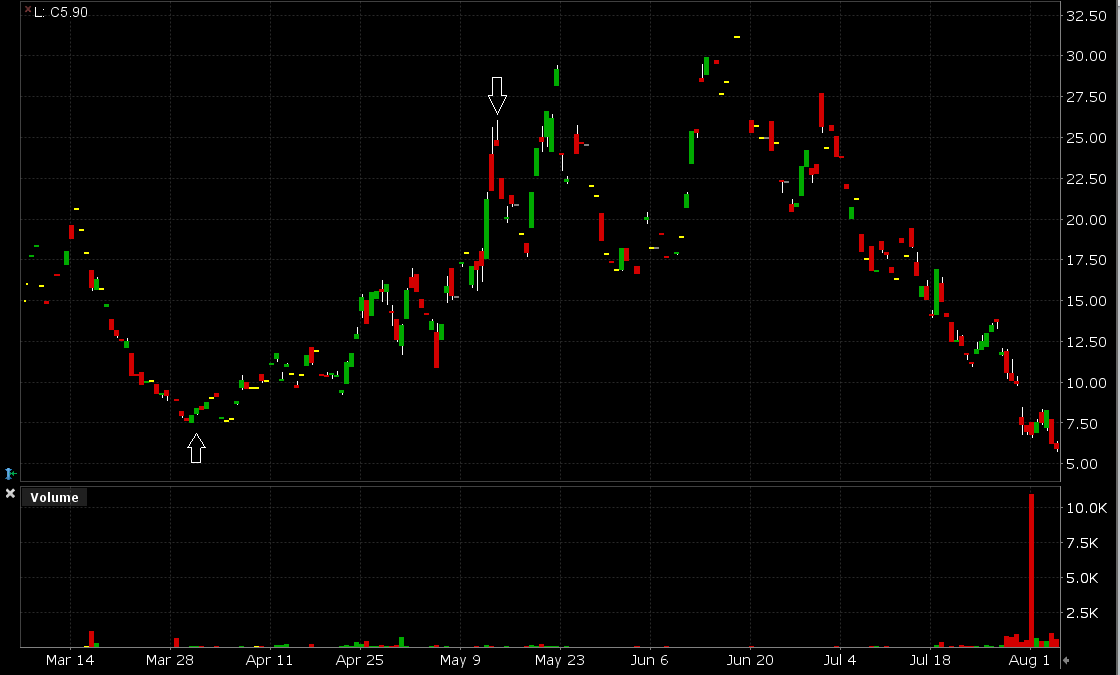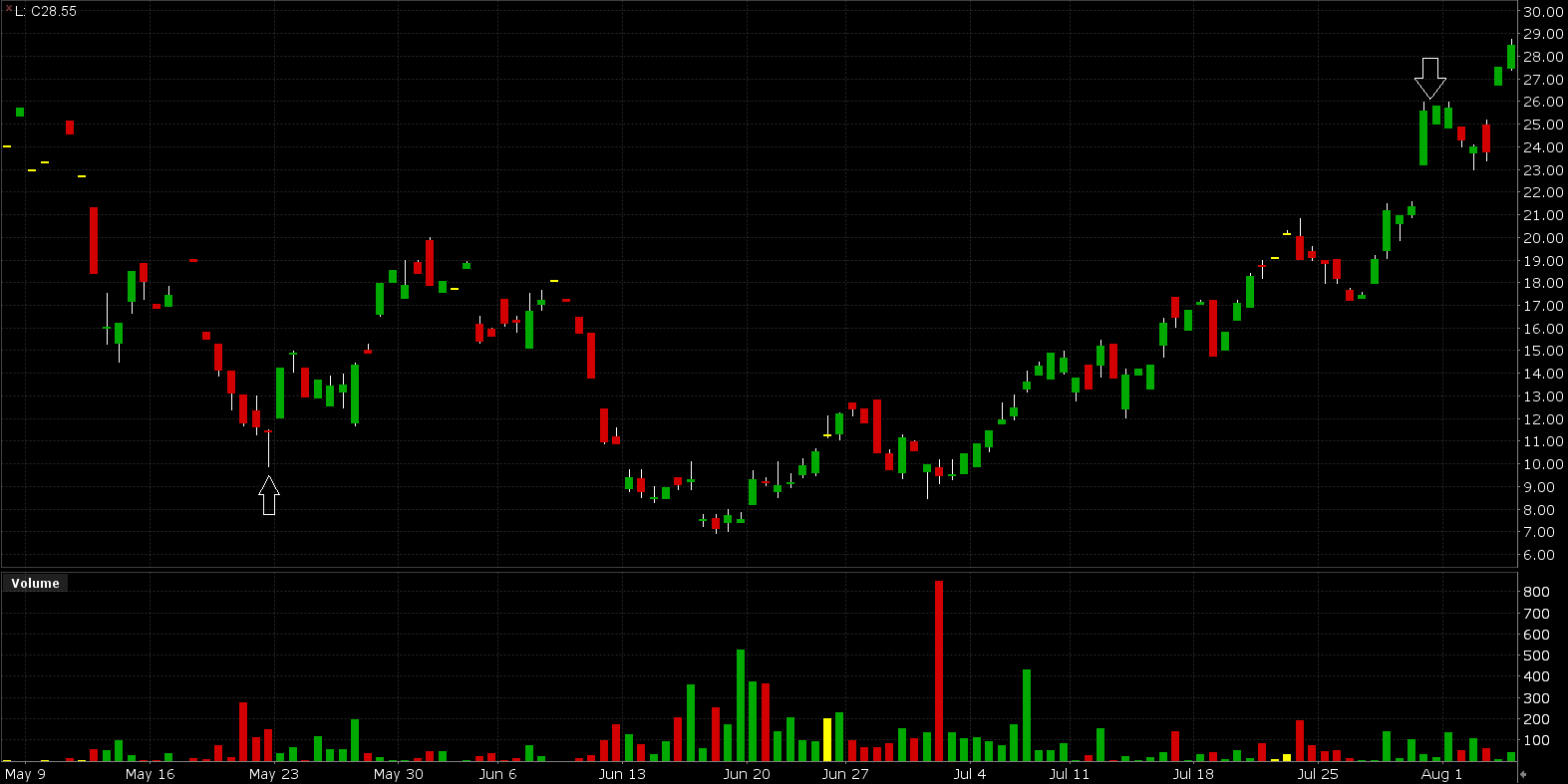Investing in options and managing a profitable position
Investing in options for many it seems fabulously simple. It is enough to buy an option, correctly select the direction of the price change and hundreds of percent of profit are at your fingertips. For this reason, many novice investors focus on buying "cheap" options that are deep beyond money (DOTM - Deep Out of The Money) in hopes of achieving a three-digit rate of return. However, managing an option position is not as easy as it initially seems. They have a big influence on the option price Greek coefficientsthat may increase or decrease the value of the option. For this reason, you should carefully consider how to manage your position. In today's article, we will present the basic issues related to managing a profitable position on the options market. We invite you to read!
List of articles on Greek coefficients:
Basic issues
As always: "Backward analysis is always effective". For this reason, many options market beginners review historical charts and “analyze” the position in terms of historical performance. As an example, you can mention the call option on Apple shares expiring on September 16, 2022 with an exercise price of $ 160. By analyzing the chart from the perspective of the past, it would be possible to mark the "ideal" place to take and close the position. However, real-time position management and the use of "back analysis" are two different disciplines. In the further part of the article, we will present the most popular strategies for managing a profitable position.
Managing a profitable position is underestimated by many. You should "Let profits grow". However, nothing is black and white. For this reason, along with your entry strategy, you need to develop a strategy to exit or hedge a profitable position in the options market. In today's article, we will present how to manage a profitable position when you have:
- long position in the call option,
- short position in the call option,
- a long position in the put option,
- a short position in a put option.
Managing a long position in a call option
By taking a long position in a call option, the investor gets the right to buy the underlying asset at a certain price within a certain period of time. In return for acquiring this right, the investor has to pay "Option premium"which is the maximum loss an investor may incur. For example, if an investor purchased a call option for Apple stocks on March 14, 2022 with an exercise price of $ 160 and an expiry date of September 16, 2022. He paid $ 12 per share for it, considering that 1 option is on 100 Apple shares, the transaction value was $ 1200. The investor does not intend to wait until the option expires, but to close the transaction when a satisfactory rate of return appears. After thirteen sessions, the price of options rose to $ 21. This means that the profit on the transaction (after excluding transaction costs) was 75%.
In the current situation, the investor can:
- let profits grow,
- close the position,
- buy a put option,
- issue a call option with a higher strike price.
On the one hand, allowing profits to grow allows you to take advantage of the further increase in the price of Apple, on the other hand, it creates a risk that there will be a change in the trend, which in the case of the negative scenario may even result in a loss on the transaction. The way out of such a situation is to create mental stops, which force you to close your position when the trend changes.
Closing a position is the second way to deal with a profitable trade. It is basically just a profit off the table. Obviously, in such a situation, there is no risk of generating a loss on the transaction (I ignore commissions). However, the disadvantage of such a solution is the possibility of missing a very profitable transaction when the optimistic scenario comes true.
Buying a put option is a solution that allows you to protect yourself against the risk of a trend reversal or a deeper correction. This has its advantages when purchasing long-term call options (LEAPS). Then, the use of short or medium-term put options will allow you to earn during the market correction. To better illustrate such a strategy, we will use an example. On March 14, 2022, 1 Apple share was valued at $ 150. The investor decided to purchase 1 call option with an exercise price of $ 160, which will expire in September 2023. The premium paid by the investor was $ 21,8 per share, i.e. the value of the premium paid was $ 2180. By March 29, Apple's stock price had risen to $ 178,75. As a result, the value of the purchased call option rose to $ 36,85.
The investor began to fear that there will be a correction in Apple shares in the next three months. For this reason, he bought a put option with an exercise price of $ 3 expiring in October 160. The value of the bonus was $ 2022 per share, or $ 7,62. By May 762, 20, Apple's stock had dropped from $ 2022 to $ 178,75. As a result, the put option price rose to $ 132,16, while the call option price dropped to $ 29,45. This meant that after just over 13 months, the transaction on the long-term call option recorded a loss of $ 2 per share, while the gain on the acquired put option was $ 8,8. After closing a position in a put option, the investor will more than cover the current and potential future losses on LEAPS holding on Apple shares.
| purchase price | Price May 20, 2022 | % change | |
| Call option | 21,8$ | 13,00$ | -59,6% |
| Put option | 7,62$ | 29,45$ | + 186 % |
| Together | 29,42$ | 42,45$ | + 44,3 % |
Source: own study
Writing a call option when you have a profit on call options allows you to reduce the potential loss in the case of the most pessimistic scenario (the value of the purchased option drops to 0) or even “guarantee” a profit on the transaction. The investor has to write an option with a higher strike price. To better illustrate the transaction, it is worth using an example. As before, the investor on March 14 purchased 1 call option with an exercise price of $ 160, which will expire in September 2023. He paid $ 21,8 per share for it. By March 29, Apple's stock price had risen to $ 178,75. As a result, the value of the purchased call option rose to $ 36,85. To protect profits, he issued a call option with an exercise price of $ 180, which expires in September 2023. From the option written, the investor received a bonus of $ 27,3 ($ 2730). This means that even in the case of the scenario in which Apple shares fall to around $ 100, the investor will achieve a profit on the transaction of $ 5,5 ($ 550).
| Transaction price | Apple $ 100 - option price | Profit / loss on the transaction | |
| long call | 21,8$ | 0 | -21,8 $ |
| short call | 27,3$ | 0 | + 27,3 $ |
Source: own study
Managing a short position in a call option
By opening a short position in a call option, the investor undertakes to sell the underlying instrument at a specified price within a specified period of time. In return for accepting this commitment, the investor receives an "option premium" which is the maximum profit the investor can make. For example, if an investor issued a call option on Apple shares on March 14, 2022 with an exercise price of $ 160 and an expiry date of September 16, 2022. He received $ 12 per share for it, considering that 1 option is issued for 100 Apple shares, the transaction value was $ 1200. After thirteen sessions, the price of options rose to $ 21. This means that the transaction loss (after excluding transaction costs) was $ 9 per share. This is an example of a loss transaction. However, let's assume that an investor puts an option at the same price, but the option price has dropped to $ 5, as a result of the transaction, $ 700 was generated from the transaction ($ 1200 - $ 500).
In the current situation, the investor can:
- let profits grow,
- close the position,
- buy a call option.
Allowing profits to grow is not the right strategy for a written call option. The reason is that the maximum profit is predetermined, while the potential loss can greatly exceed the potential profit. Therefore, in order to properly manage the risk, the investor should decide to close the position if more than half of the premium has already “evaporated” from the issued option.
Buying a call option allows you to protect yourself against a situation when the investor is afraid that a short, upward correction on the underlying instrument is possible. However, such a solution is puzzling from the point of view of portfolio risk management. If writing a call option carries the risk of generating a huge loss in the event of an upward correction, maybe a better solution is to close a short position with profit and buy a call option?
Managing a short position in the put option
By opening a short position in the put option, the investor undertakes to buy the underlying instrument at a specified price within a specified period of time. In return for accepting this commitment, the investor receives an "option premium" which is the maximum profit the investor can make. At the same time, the investor is exposed to the risk of a sharp drop in the price of the underlying instrument, which will cause the loss to significantly exceed the maximum profit. Occasionally, investors issue a put option to buy a stock at a lower price than the current price ("making money" with a time premium).
For example, if an investor issued a put option on Apple shares on March 15, 2022 with an exercise price of $ 160 and an expiry date in September 2023. He received $ 25,5 per share for it, considering that 1 option is on 100 Apple shares, the transaction value was $ 2550. By March 29, 2022, the option price had dropped to $ 15,15. This means that the investor generated a profit of $ 1035 ($ 10,35 * multiplier).
In the current situation, the investor can:
- let profits grow,
- close the position,
- buy a put option.
Allowing profits to grow is not the right strategy for a written call option. The reason is that the maximum profit is predetermined, while the potential loss can greatly exceed the potential profit. Therefore, in order to properly manage the risk, the investor should decide to close the position if more than half of the premium has already “evaporated” from the issued option.
Buying a put option allows you to protect yourself against the situation when the investor is afraid that a short, downward correction on the underlying instrument is possible. However, such a solution is puzzling from the point of view of portfolio risk management. If issuing a put option involves the risk of generating a huge loss in the event of a downward correction, maybe a better solution is to close a short position with a profit and buy a put option?
Managing a long position in the put option
By taking a long position in the put option, the investor gets the right to sell the underlying instrument at a certain price within a certain period of time. In return for acquiring this right, the investor must pay an "option premium" which is the maximum loss the investor may incur.
For example, if an investor purchased a put option on Apple shares on March 30, 2022 with an exercise price of $ 160 and an expiry date of October 2022. He paid $ 7,5 per share for it, considering that 1 option is on 100 Apple shares, the transaction value was $ 750. The investor does not intend to wait until the option expires, but to close the transaction when a satisfactory rate of return appears. On May 12, 2022, the option price rose to $ 24,5. This means that the profit on the transaction (after excluding transaction costs) was 226%.
In the current situation, the investor can:
- let your profits grow
- close the position
- buy a call option
- issue a put option with a lower strike price
On the one hand, allowing profits to grow allows you to take advantage of a further decline in the price of Apple, on the other hand, it creates a risk that there will be a trend change, which in the case of a negative scenario may even result in a loss on the transaction. The way out of this situation is mental formation stop losseswhich force the position to close in the event of a trend change.
Closing a position is the second way to deal with a profitable trade. It is basically just a profit off the table. Obviously, in such a situation, there is no risk of generating a loss on the transaction (I ignore commissions). However, the disadvantage of such a solution is the possibility of missing a very profitable transaction when the optimistic scenario comes true.
Buying a call option is a solution that allows you to protect yourself against the risk of a trend reversal or a deeper correction. This has its advantages when purchasing long-term put options (LEAPS). Then the use of short or medium-term call options will allow you to earn during the market correction. To better illustrate such a strategy, we will use an example.
On March 29, 2022, 1 Apple share was valued at $ 178. The investor has decided to buy 1 put option with an exercise price of $ 170, which will expire in September 2023. The premium paid by the investor was $ 19,2 per share. By May 20, Apple's stock had dropped to $ 132,16 on the stock exchange. As a result, the value of the put option purchased rose to $ 37. The investor began to fear that there will be a correction in Apple shares in the next three months. For this reason, he purchased a call option with an strike price of $ 3 expiring in October 140. The value of the bonus was $ 2022 per share, or $ 10. By August 1000, 1, Apple's share price had dropped from $ 2022. As a result, the price of the call option increased to $ 161,5, while the price of the put option dropped to $ 26. This meant that after just over 22,5 months, the transaction on the long-term put option recorded a profit of $ 2 per share, while the profit on the acquired call option was $ 3,3.
| purchase price | Price May 20, 2022 | % change | |
| Put option | 19,2$ | 22,5$ | + 17,2 % |
| Call option | 10,0$ | 26$ | + 160 % |
| Together | 29,2$ | 48,5$ | + 66,1 % |
Issuing a put option when you have a profit on put options allows you to reduce the potential loss in the case of the most pessimistic scenario (increase in the value of the purchased option) or even "guarantee" a profit on the transaction. The investor has to write an option with a lower strike price. To better illustrate the transaction, it is worth using an example.
As before, on March 29, the investor purchased 1 put option with an exercise price of $ 160, which will expire in September 2023. He paid $ 19,2 per share for it. By May 20, Apple's stock had dropped to $ 132,16 on the stock exchange. As a result, the value of the put option purchased rose to $ 37. To protect profits, he issued a put option with an exercise price of $ 150 that expires in September 2023. The trader received a premium of $ 27,75 ($ 2775) from the option written. This means that even in the case of the scenario in which Apple shares increase to around $ 200, the investor will achieve a profit on the transaction of $ 8,55 ($ 855).
| Transaction price | Apple $ 200 - option price | Profit / loss on the transaction | |
| long put | 19,2$ | 0 | -19,2 $ |
| short put | 27,75$ | 0 | + 27,75 $ |
Source: own study
Do you know that…?
Saxo Bank is one of the few Forex brokers that offers vanilla options. The investor has a total of over 1200 options at his disposal (currencies, stocks, indices, interest rates, raw materials). CHECK






















![Forex Club – Tax 9 – Settle tax on a foreign broker [Download the Application] Forex Club - Tax 9](https://forexclub.pl/wp-content/uploads/2024/02/Forex-Club-Podatek-9-184x120.jpg?v=1709046278)
![Trading View platform – solutions tailored to the needs of traders [Review] trading view review](https://forexclub.pl/wp-content/uploads/2024/03/trading-view-recenzja-184x120.jpg?v=1709558918)
![How to connect your FP Markets account to the Trading View platform [Guide] fp markets trading view](https://forexclub.pl/wp-content/uploads/2024/02/fp-markets-trading-view-184x120.jpg?v=1708677291)
![How to invest in ChatGPT and AI? Stocks and ETFs [Guide] how to invest in chatgpt and artificial intelligence](https://forexclub.pl/wp-content/uploads/2023/02/jak-inwestowac-w-chatgpt-i-sztuczna-inteligencje-184x120.jpg?v=1676364263)






![Izabela Górecka – “Success on the market depends not only on knowledge, but also on emotional stability” [Interview] Izabela Górecka - interview](https://forexclub.pl/wp-content/uploads/2024/04/Izabela-Gorecka-wywiad-184x120.jpg?v=1713870578)
![WeWork – the anatomy of the collapse of a company valued at $47 billion [WeWork, part II] wework bankruptcy story](https://forexclub.pl/wp-content/uploads/2024/04/wework-bankructwo-historia-184x120.jpg?v=1711729561)
![Adam Neumann – the man who screwed up Softbank [WeWork, part AND] adam neumann wework](https://forexclub.pl/wp-content/uploads/2024/04/adam-neumann-wework-184x120.jpg?v=1711728724)


![The most common mistakes of a beginner trader - Mr Yogi [VIDEO] Scalping - The most common mistakes of a beginner trader - VIDEO](https://forexclub.pl/wp-content/uploads/2024/03/Scalping-Najczestsze-bledy-poczatkujacego-tradera-VIDEO-184x120.jpg?v=1711601376)
![Learning patience: No position is also a position - Mr Yogi [VIDEO] Scalping - Learning patience - No position is also a position - VIDEO](https://forexclub.pl/wp-content/uploads/2024/03/Scalping-Nauka-cierpliwosci-Brak-pozycji-to-tez-pozycja-VIDEO-184x120.jpg?v=1710999249)
![When to exit a position and how to minimize losses - Mr Yogi [VIDEO] Scalping - When to exit a position and how to minimize losses - VIDEO](https://forexclub.pl/wp-content/uploads/2024/03/Scalping-Kiedy-wyjsc-z-pozycji-i-jak-minimalizowac-straty-VIDEO-184x120.jpg?v=1710336731)















Leave a Response